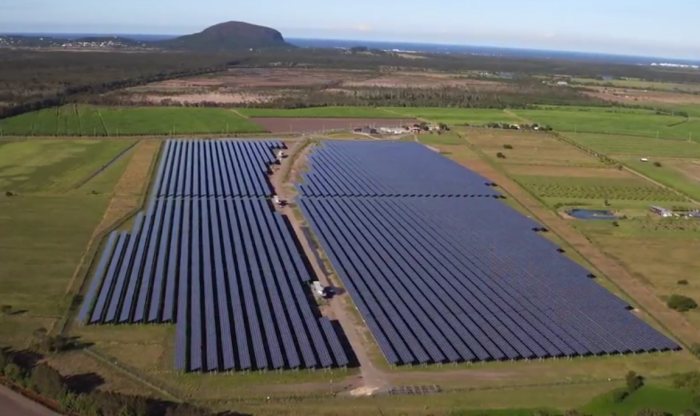
Queensland’s Sunshine Coast Council is more than happy with the first 12 months’ performance of its 15MW solar farm – benefiting from electricity savings beyond forecasts.
Connected to the grid on July 24 last year, Sunshine Coast Solar Farm has saved Council $1.7 million so far, more than double the amount it had hoped for in the first year said acting Mayor Tim Dwyer.
The clean energy facility was originally expected to provide $22 million in savings after costs over a 30-year period based on current electricity prices. Council says the solar farm is offsetting more than 100% of its energy usage across all its facilities and operations. In January this year, it enabled council to offset 129% of its total electricity consumption.
The project marked the first time in Australia a local government has constructed a solar farm to offset the electricity use of all its operations.
According to the power station’s live data page, it has generated 27,232.7 MWh of electricity since construction was completed, avoiding 21,241.5 tonnes of carbon emissions in the process. Its best energy day was December 7, 2017, when 121.5MW of electricity was generated. Its peak power day was in September, when it hit 14.8MW1
Sunshine Coast Solar Farm is located at Valdora and consists of 57,850 Trina Solar panels and SMA inverter/power conversion equipment. The project has won three awards, including taking out the sustainability category at the Local Government Managers Australia excellence awards in Brisbane earlier this year.
Sunshine Coast Powers Ahead With Solar Energy
Before the solar farm, Council had already installed PV modules on dozens of its buildings; including six libraries, various halls and community centres and the Sunshine Coast Stadium, which has the largest system at 33.6kW. The electricity generated by these other systems averages out to 242,214 kWh per year.
Solar power on the Sunshine Coast has grown rapidly thanks also to the efforts of residents and businesses, with more than 40,000 systems installed across the region. Council is keen to see more panels on rooftops and to help residents make the most from installations currently in place.
“Over the next six months, we’ll be pulling together independent information from trusted experts and sharing that with our residents and businesses,” said Division 9 Councillor Steve Robinson. “We want to help our community learn how to reap maximum savings from their existing solar PV system, what renewable options are available, how to choose an energy provider and how to reduce their home’s energy usage.”
Footnotes
- It’s quite normal for a solar installation, large or small, to not reach its nameplate power output – the reasons why can be found here ↩

 RSS - Posts
RSS - Posts



So, 21% Capacity Factor.
I was recently told by the sales person that I could expect 28% CF in SIngleton, NSW on a proposed 6kW rooftop system.
I received a blank stare when I queried the higher than expected CF. Was expecting 22 to 24%.
My point is thus: is 21% CF in SE Queensland as expected, or a little low? The article didn’t say what was expected, only what was produced.
I’d love to hear why a salesperson might use generous estimates, when perhaps a more conservative approach would result in more happy customers.
I would expect maybe a 17% capacity factor for north facing solar in Singleton, probably less. No idea how they managed to get 28%.
I would expect the Sunshine Coast solar farm to have perhaps an 18% capacity factor so 21% is an excellent result.
I guess that my suspicions have been rewarded. It could well be that the conflicted salesperson took a gamble that, by salting his ore, about 50% greater reward was predicted than that which was probable. Hence a very short payback period was calculated: I don’t recall what that was supposed to be.
In any case, I heard nothing more from him or his company, after asking for basic documentary explanation of the performance of solar collectors and other devices.
I do recall asking why, for a calculated 6.6 kW system (I presumed DC, but maybe the calculations were based on AC sent out, the recommended inverter was 5.5kW. Again, interesting and still unexplained.
Needless to say, my roof still has no panels, apart from for a hot water system which does a stirling job.
My thoughts, then and still, were that companies dealing in technically complex matters should perhaps be required to have a licence and to be required to use standardised definitions of terms.
And yes, I am an engineer, with degree and all that, but not specifically in PV systems. My experience includes several decades in coal fired power stations. But, having tried and failed to understand the mumbo-jumbo, I eventually did not proceed.
I’m afraid that company you dealt with sounds very dodgy. One thing I can can clear up is that rooftop solar capacity is measured in the total DC capacity of the panels. Because panels rarely operate at their rated output it is common for panel capacity to be larger than inverter capacity. It can be up to one-third larger for a normal installation and this has little effect on total output.
If you are interested in quotes from reliable installers who have been vetted by my boss, Finn, you can go here:
https://www.solarquotes.com.au/
And enter your postcode in the upper right corner and answer the questions that come up as best you can.
Many thanks.
I must admit to having given up several years back, when I realised that my technical background and commercial caution were getting me nowhere.
Two firms evaporated when I asked questions, one of which you have just answered without fuss.
It’s time for bed. And for contemplation. And thanks again.